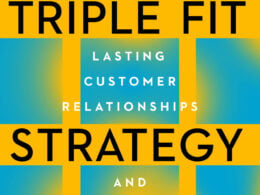The following is excerpted from “Make It Don’t Fake It” by Sabrina Horn (2021), ISBN 978-1523091492, with permission from Berrett-Koehler Publishers.
There are many definitions of “brand.” I think of it simply as the unique relationship a person has with a company and what the company produces and sells. Successful brands create the feeling of trust that buying a certain company’s products or services delivers real and reliable benefits. To succeed, a brand must always represent reality. It must be and remain authentic. Yet, as we know, reality is always changing. Businesses grow, markets shift and buying behaviors evolve. Creating an authentic brand is hard enough. Evolving and maintaining that brand’s authenticity over time is extraordinarily complex and challenging, both art and science.
But at the core, there is also something starkly simple about it. A brand’s representation of reality begins with and grows under the leadership of a company’s founders, its CEO and its top executives. It continually surprises me that so many leaders fail to grasp how much the creation and protection of a sustainable brand is in their hands. Too often, they think that branding is something that comes “later.” Assigned to consultants and marketing people with varying degrees of expertise, the creation of the brand is put at risk of becoming a kind of bolt-on feature. That doesn’t mean it’s fake; it’s just not very organic to the product, the service or the organization. This can diminish its authenticity.
A brand should be rooted in a company’s heritage and culture, connected to a set of core values that are the company’s very reason for being.
StartupNation exclusive discounts and savings on Dell products and accessories: Learn more here
Here is what you need to know to make an authentic brand come to life:
The value of leadership
A reality-grounded CEO manages, protects and leads the brand by managing, protecting and leading the culture and values behind it.
A 2019 trend report from Forrester Research predicted in 2020 that consumers would search for “deeper meaning” in the products and services they purchase, going on to explain, “More than 55% of consumers will consider company values when making a buying decision.” Companies that do succeed will create value-driven experiences with customers and employees.
The 2019 report came out before the COVID-19 pandemic, which has made its insights even more important. For the next several years, I believe love-based marketing and empathetic, values-based communication, something about which I have spoken and written, will play an increasingly important role in branding. Going forward, it will be about connecting with consumers and the consumer experience on a much deeper level, to win their trust and make them feel safe. Successful brands will need to exude messages of care and understanding (as opposed to fear), of hope for a better tomorrow and to inspire their audiences with courage, resilience and inclusivity.
Related: Expert Advice for the 4 Million People Who Launched a Business in 2020
For many leaders, this will require revisiting and perhaps reprioritizing their core values in the context of the current environment. It also will require a serious shift in marketing strategy to address what a July 2020 article from research firm Gartner Group calls a wave of “systemic mistrust,” in which consumer trust has reached new lows. It is “possible that over the long term,” Gartner observed, “a common enemy in the virus will inspire empathy, common purpose and cooperation,” which will benefit brands that broadcast messages of openness, authenticity, and empathy.”
Furthermore, we know from research issued by Weber Shandwick, a global public relations firm, that global executives attribute 45% of their company’s reputation and 44% of their company’s market value to the reputation of their CEO. This is the so-called CEO reputation premium, and in addition to enhancing market value, a strong CEO reputation is overwhelmingly important in attracting investors, generating positive media attention, affording crisis protection, attracting new employees and retaining current employees.
Recall what happened when Steve Jobs, so thoroughly identified with the value of Apple, passed away in 2011. Speculation was rampant that the Apple brand of quality, must-have design, service and innovation would slump. But while Jobs was a creative genius and a celebrity, his public reputation was often described as hot-tempered, mercurial and tyrannical. The new CEO, Tim Cook, formerly Apple’s chief operating officer, was largely unknown by comparison and lacked Jobs’ larger-than-life presence. Consumers and investors alike wondered, with Jobs gone, would Apple’s magic go along with him? Would even the Apple loyalists stray and key talent jump ship?
Cook was his own man and neither evaded nor denied these concerns. He was no Steve Jobs, and he did not try to be. Knowing full well that consumers and investors were watching, Cook authentically and meticulously proved that, despite the changing of the guard, every feature of the brand and of the company’s financial performance would remain consistent.
By 2020, in fact, he led Apple to become the first American company to achieve a trillion-dollar valuation. Under his leadership, the brand continued to fulfill its promise with subsequent releases of the iPhone, Apple Watch, AirPods and other devices. Cook also took on social causes, such as the environment and diversity, something for which Jobs didn’t have much of an appetite. Of course, it was the people of Apple who carried this out, but the commitment to the brand flowed from him. All in all, it was a remarkably successful evolution of leadership, values and brand.
Not all CEOs are brands in themselves, and few CEOs are seamlessly identified with their companies and brands. Most aren’t. In fact, many of the brands with which we identify are simply product names, like Oreo, PAM, SlimFast, Varathane and WD-40. We may have no sense of the people or companies behind them.
Whatever your branding strategy, however, it is always based on a belief and value system that was created by someone — an inventor, founder, entrepreneur or leader — who stands behind it. At the end of the day, it is the leadership of a company, the CEO, who is responsible for the success and failure of their business and the brands they represent.
Sign Up: Receive the StartupNation newsletter!
It’s your brand. Own it.
In the end, you as the CEO, and by extension, your leadership team, must steward your brand. You can shape it, grow it, modify it, but you must never let go of its function as the messenger of your company’s promise. As the CEO, the top dog, word from you is powerful and packs a lot of juice. When it comes to branding, you are the ultimate keeper of the flame. You cannot delegate that responsibility entirely. If you do, you’ll surrender control of your company’s identity.
In the end, this is a major responsibility. You are the head of state of your company, what it stands for and its brand. You will need the help and advice of others. You must listen very carefully to your leadership team and to other stakeholders. You may at times feel lost in a clamoring crowd, but you must know that, despite all the noise around you, you alone are in charge and responsible. Ultimately, it all really does rest with you.
And that feeling is both very awesome and, at times, quite lonely.
“Make It Don’t Fake It” is available now and can be purchased via StartupNation.com






